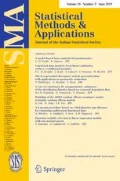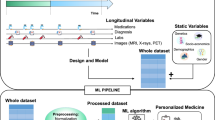Abstract
We propose new time-dependent sensitivity, specificity, ROC curves and net reclassification indices that can take into account biomarkers or scores that are repeatedly measured at different time-points. Inference proceeds through inverse probability weighting and resampling. The newly proposed measures exploit the information contained in biomarkers measured at different visits, rather than using only the measurements at the first visits. The contribution is illustrated via simulations and an original application on patients affected by dilated cardiomiopathy. The aim is to evaluate if repeated binary measurements of right ventricular dysfunction bring additive prognostic information on mortality/urgent heart transplant. It is shown that taking into account the trajectory of the new biomarker improves risk classification, while the first measurement alone might not be sufficiently informative. The methods are implemented in an R package (longROC), freely available on CRAN.

Similar content being viewed by others
References
Basili S, Loffredo L, Pastori D, Proietti M, Farcomeni A, Vestri AR, Pignatelli P, Davi G, Hiatt WR, Lip GY, Corazza GR, Perticone F, Violi F (2017) Carotid plaque detection improves the predictive value of CHA2DS2-VASc score in patients with non-valvular atrial fibrillation: the ARAPACIS study. Int J Cardiol 231:143–149
Cardellini M, Farcomeni A, Ballanti M, Morelli M, Davato F, Cardolini I, Grappasonni G, Rizza S, Gugliemi V, Porzio O, Pecchioli C, Menghini R, Ippoliti A, Federici M (2017) C-peptide: a predictor of cardiovascular mortality in subjects with established atherosclerotic disease. Diabetes Vasc Dis Res 4:395–399
Farcomeni A, Viviani S (2011) Robust estimation for the Cox regression model based on trimming. Biomet J 53:956–973
Farcomeni A, Ventura L (2012) An overview of robust methods in medical research. Stat Methods Med Res 21:111–133
Gerds TA, Kattan M, Schumacher M, Yu C (2013) Estimating a time-dependent concordance index for survival prediction models with covariate dependent censoring. Stat Med 32:2173–2184
Gulati A, Ismail T, Jabbour A, Alpendurada F, Guha K, Ismail N, Raza S, Khwaja J, Brown T, Morarji K, Liodakis E, Roughton M, Wage R, Pakrashi T, Sharma R, Carpenter J, Cook S, Cowie M, Assomull R, Pennell D, Prasad S (2013) The prevalence and prognostic significance of right ventricular systolic dysfunction in nonischemic dilated cardiomyopathy. Circulation 128:1623–1633
Heagerty P, Lumley T, Pepe M (2000) Time-dependent ROC curves for censored survival data and a diagnostic marker. Biometrics 56:337–344
Iacovelli R, Farcomeni A, Sternberg CN, Carteni G, Milella M, Santoni M, Cerbone L, Di Lorenzo G, Verzoni E, Ortega C, Sabbatini R, Ricotta R, Procopio G (2015) Prognostic factors in patients receiving third-line targeted therapy for metastatic renal cell carcinoma. J Urol 193:1905–1910
Jeong J-H, Jung S-H, Costantino JP (2008) Nonparametric inference on median residual life function. Biometrics 64:157–163
Jung S-H, Jeong J-H, Bandos H (2009) Regression on quantile residual life. Biometrics 65:1203–1212
Kurland BF, Johnson LL, Egleston BL, Diehr PH (2009) Longitudinal data with follow-up truncated by death: match the analysis method to research aims. Stat Sci 24:211–222
Li L, Greene T, Hu B (2017) A simple method to estimate the time-dependent receiver operating characteristic curve and the area under the curve with right censored data. Stat Methods Med Res. http://doi.org/10.1177/0962280216680239
Merlo M, Pyxaras S, Pinamonti B, Barbati G, Di Lenarda A, Sinagra G (2011) Prevalence and prognostic significance of left ventricular reverse remodeling in dilated cardiomyopathy receiving tailored medical treatment. J Am Coll Cardiol 57:1468–1476
Merlo M, Pivetta A, Pinamonti B, Stolfo D, Zecchin M, Barbati G, Di Lenarda A, Sinagra G (2014) Long-term prognostic impact of therapeutic strategies in patients with idiopathic dilated cardiomyopathy: changing mortality over the last 30 years. Eur J Heart Fail 16:317–324
Merlo M, Gobbo M, Stolfo D, Losurdo P, Ramani F, Barbati G, Pivetta A, Di Lenarda A, Anzini M, Gigli M, Pinamonti B, Sinagra G (2016) The prognostic impact of the evolution of right ventricular function in idiopathic dilated cardiomyopathy. J Am Coll Cardiol Cardiovasc Imaging 9:1034–1042
Pencina MJ, D’Agostino RB, Vasan RS (2008) Evaluating the added predictive ability of a new marker: from area under the ROC curve to reclassification and beyond. Stat Med 27:157–172
Pencina M, D’Agostino R, Steyerberg E (2011) Extensions of net reclassification improvement calculations to measure usefulness of new biomarkers. Stat Med 30:11–21
Pencina MJ, D’Agostino RB, Pencina KM, Janssens CJW, Greenland P (2012) Interpreting incremental value of markes added to risk prediction models. Am J Epidemiol 176:473–481
Pepe MS (2003) The statistical evaluation of medical tests for classification and prediction. Oxford University Press, Oxford
Pignatelli P, Pastori D, Carnevale R, Farcomeni A, Cangemi R, Nocella C, Bartimoccia S, Vicario T, Saliola M, Lip GYH, Violi F (2015) Serum NOX2 and urinary isoprostanes predict vascular events in patients with atrial fibrillation. Thromb Haemost 113:617–624
Riggio O, Amodio P, Farcomeni A, Merli M, Pasquale C, Nardelli S, Pentassuglio I, Gioia S, Onori E, Piazza N, Montagnese S (2015) A model for the prediction of overt hepatic encephalopathy in patients with cirrhosis. Clin Gastroenterol Hepatol 13:1346–1352
Rizopoulos D (2011) Dynamic predictions and prospective accuracy in joint models for longitudinal and time-to-event data. Biometrics 67:819–829
Robertson T, Wright FT, Dykstra RL (1988) Order restricted statistical inference. Wiley, New York
Schoop R, Graf E, Schumacher M (2008) Quantifying the predictive performance of prognostic models for censored survival data with time-dependent covariates. Biometrics 64:603–610
Uno H, Cai T, Tian L, Wei L (2007) Evaluating prediction rules for t-year survivors with censored regression models. J Am Stat Assoc 102:527–537
Uno H, Tian L, Cai T, Kohane I, Wei LJ (2013) A unified inference procedure for a class of measures to assess improvement in risk prediction systems with survival data. Stat Med 32:2430–2442
Venkatraman ES (2000) A permutation test to compare receiver operating characteristic curves. Biometrics 56:1134–1138
Zheng Y, Heagerty P (2004) Semiparametric estimation of time-dependent ROC curves for longitudinal marker data. Biostatistics 5:615–632
Zheng Y, Heagerty P (2005) Partly conditional survival models for longitudinal data. Biometrics 61:379–391
Acknowledgements
The authors are grateful to an AE and two referees for kind comments that helped improve the presentation.
Author information
Authors and Affiliations
Corresponding author
Rights and permissions
About this article
Cite this article
Barbati, G., Farcomeni, A. Prognostic assessment of repeatedly measured time-dependent biomarkers, with application to dilated cardiomyopathy. Stat Methods Appl 27, 545–557 (2018). https://doi.org/10.1007/s10260-017-0410-2
Accepted:
Published:
Issue Date:
DOI: https://doi.org/10.1007/s10260-017-0410-2




